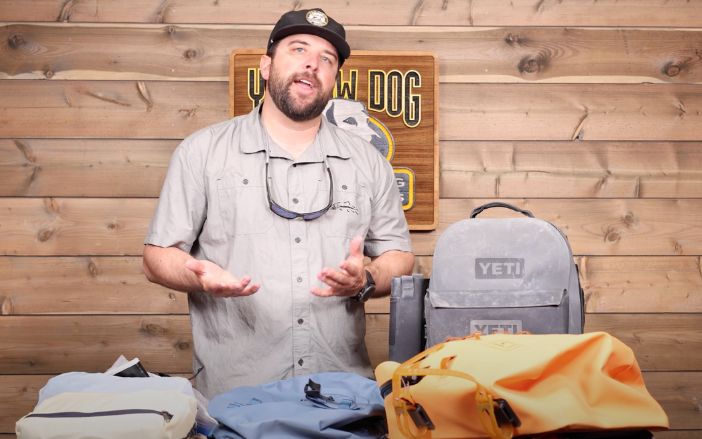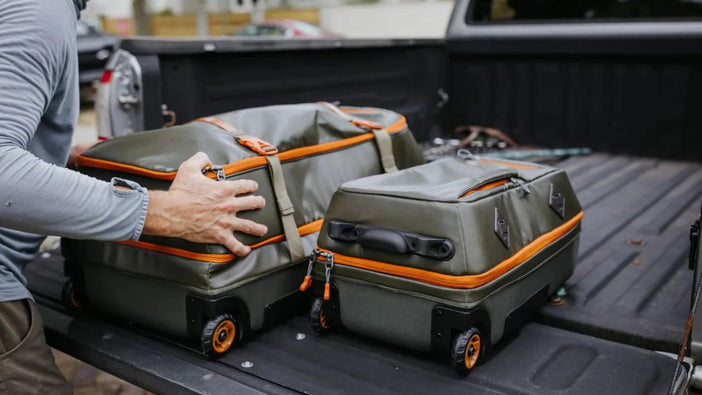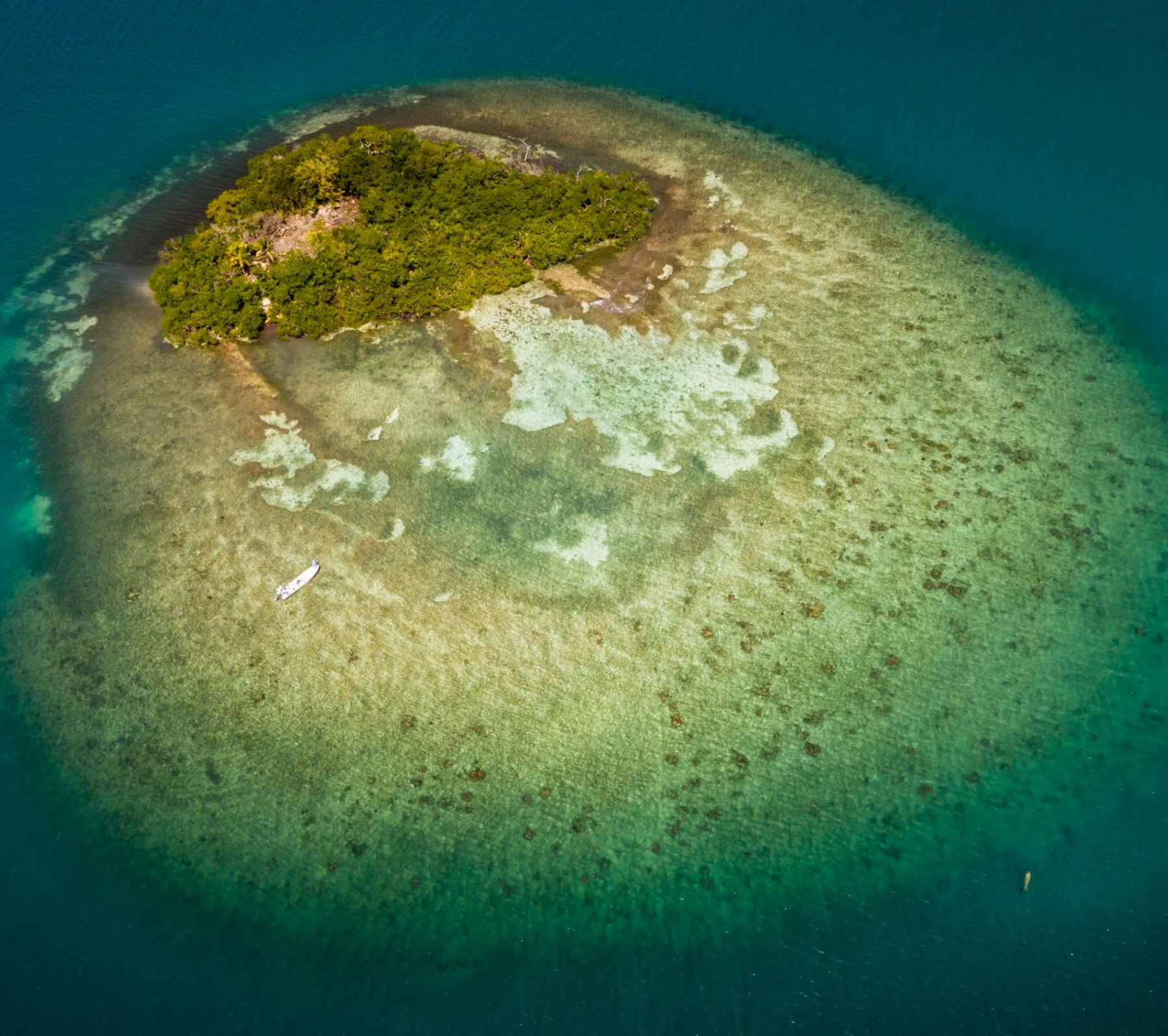While small, the Latin American country of Belize has established itself as one of the best locations for saltwater fly fishing. The destination offers anglers distinct fisheries in the northern peninsula of Ambergris Caye, along its coastline on the mainland, and some of the world's most notable permit flats offshore in the south. The gear and flies you will need for Belize will vary depending on your destination, so to ensure you arrive prepared, we have provided an all-encompassing guide specific to Belize that provides insights, options, and gear recommendations for your time on the flats.
For destination-specific equipment for Belize's prominent regions, follow the links below:
+ Belize Equipment List Video Series
- Fly Selection for Bonefish, Permit, and Tarpon in Belize
- Fly Rod and Reel Setups for Fly Fishing in Belize
- Essential Fly Lines, Leaders, and Tippet for Fly Fishing in Belize
- Wading Boots and Packs for Fly Fishing in Belize
- Selecting Apparel and Sunglasses for Fly Fishing in Belize
- Must Have Items and Travel Tips for Belize
What Fly Rods Should I Bring?
The entirety of Belize's coastal region is a productive fishery, so where you are traveling specifically will dictate the rods and reels you will need. The first and most important factor is that you are selecting a saltwater fly rod--one designed to stand up to the conditions and target species, but more importantly, allows for you to make quick and precise casts.
The fishery surrounding Ambergris Caye is home to all of the major game species, so anglers hoping to target them all have to prepare accordingly. The mainland coast of Belize is home to fantastic tarpon and snook fishing, with legitimate opportunities for permit and bonefish nearby. To the south, permit are generally the primary target, but tarpon and bonefish can also be found depending on your preferences. The key to selecting the right gear for you is to consider where you are heading, what species are available, and what your primary focus will be. Below we have provided some suggestions broken down by species:
Permit
The waters surrounding Ambergris Caye, Caye Caulker, and the southern flats of Belize have been some of the best permit fisheries for decades. A 9' 9-weight is a great option for permit, but we also recommend a 9' 10-weight for casting the heavily-weighted flies that are sometimes used. If permit are your primary target for your time in Belize, bring one of each to allow you to switch between rods rapidly. Often, a guide may have a shrimp pattern on one rod and a crab fly on another to maximize your chances if the first fly is refused.
Bonefish
Bonefish are abundant in Belize, especially in the north, and are generally in the one-to-four-pound range. A 9' 8-weight is your best all-around option for bonefish in Belize, though a 9' 7-weight is a great option for low-wind scenarios, delicate presentations, and casting at closer ranges on foot.

Tarpon
For any saltwater destination, you should always bring multiple rods. For juvenile tarpon, a 9' 9-weight is ideal, though an 8 or 10-weight would work well depending on the size of the fish around. We suggest having at least two rods in case of breakage or to allow for the use of both floating and intermediate lines. In addition, a second rod allows you quickly show the fish another fly after a refusal without having to select and tie on another pattern.
Adult tarpon demand a lot more from your equipment. A 9' 10, 11, or 12-weight is recommended with a fighting butt and a strong, reliable bottom section for fighting the fish. Adult tarpon are known to break even the strongest of rods--a worthy occupational hazard for these giants, so a backup rod is a must-have if you plan on dedicating a significant portion of your trip to them. We recommend bringing a single 9' 11-weight if you want to be prepared for an adult tarpon encounter while focusing on other species.
Snook
Your tarpon or permit rod will work well for pursuing snook. Snook are most commonly found cruising along the mangroves or sheltered within the pockets of the mangroves, poised to ambush prey. You want a rod capable of casting flies at distance into tight spaces and the strength to ensure you can pull the snook away from the mangroves once hooked. A fast-action rod with a softer tip could work well here--allowing anglers to cast with both speed, distance, and precision. If you keep snagging the mangroves, don't beat yourself up--if you aren't snagging the mangroves at least once in a while, you likely aren't casting close enough.
Barracuda/Jacks
Again, your 9' 10-weight is going to work well here. It is very common to stumble upon a school of cruising jacks or a solitary barracuda in the northern waters of Belize. Both are hard-fighting, willing, and voracious eaters of a fly--we always recommend you be prepared for these often overlooked game species!
In summary, we recommend you adjust your rod quiver depending on the primary focus of your trip. If this is your first saltwater trip and you are eager to gain some experience with bonefish, bring a 9' 8-weight for bonefish and a 9' 10-weight as an option for pursuing other species. If you prefer to focus on catching your first permit, a 9 and 10-weight are ideal, and a backup rod in case of incidentals. If you want to cover all of your bases, an 8, 9, 10, and 11-weight will leave you prepared for almost any situation.
Selecting the Right Reel
Many guides will tell you a high-quality reel is going to be one of the most important components in an angler's quiver. With an abundance of options on the market, there are a few characteristics a reel MUST have when investing in a saltwater fly reel.
- Built to Last: Make sure the reel is anodized--a process that strengthens the aluminum most reels are made of. Anodized reels are more durable and can stand up to the demanding conditions of saltwater far better than your average trout reel. Most any reel currently designed for saltwater will be anodized--highlighting how it is a necessity, not a choice.
-
Backing: Backing capacity is a crucial component in selecting the right reel for your trip. We suggest the following:
- Bonefish: Ensure you have between 150-250 yards of 20# backing for your bonefish setup. While this will likely be more than you could ever need, saltwater fly fishing is often unpredictable, and running out of backing is not an experience you want to encounter. If a permit or mutton snapper suddenly appears and you only have seconds to make the shot--you'll be glad you have the extra backing.
- Permit: It isn't uncommon to need at least 200 yards of backing for a permit--they are fast, powerful, and have a fighting spirit. A reel with 200-250 yards of 30# backing is recommended, especially if you hook into the permit we all dream of.
- Tarpon: Adult tarpon require the very best in rods, reels, and terminal tackle, while a juvenile tarpon in the 20-pound range does not require much backing, a migratory adult is another animal. If you are targeting larger tarpon, a reel with 200-300 yards of 30# backing is recommended. For juveniles, 150-200 yards of 20# backing will be plenty.
- Other: Your permit and/or tarpon rod will cover most any other encounter on the flats, including jacks, barracuda, and snook.
- Mid-to-Large Arbor: A reel's arbor is the component where line and backing are stored and determines how quickly you can retrieve the line. A larger arbor means anglers can reel in more line with each rotation of the reel handle. If the permit you are fighting suddenly turns back toward you, you need the ability to immediately pick up the slack in the line to maintain tension--it could make the difference between landing or losing that fish.
- Drag System: Whether purchasing a sealed drag or a cork system, a strong, reliable drag system is important for putting the brakes on your quarry. Most modern saltwater reels will work here and can last a lifetime if well-maintained. A very basic rule of thumb is: The bigger and stronger the fish, the more important your reel's drag system is, and you should invest accordingly.

Choosing A Saltwater Fly Line
The most critical aspect of selecting a fly line for Belize is a line designed for tropical environments. That striper line you have hanging around is going to cast like a wet towel and will undoubtedly leave you frustrated and without a fish to hand. All the top brands make great lines, but finding the taper that works best for your rod and casting stroke comes with a little experimentation. Selecting a high-quality, weight-forward, floating line that is rated for your rod's weight is the best approach, although an "overweighted" or "overlined" rod has some casting benefits (EX: Using a 9-Weight rated line on an 8-Weight).
Most fly fishing destinations abroad will not offer you access to fly lines if you aren't prepared, so we recommend bringing a backup line. A coral mound, a skiff propeller, or a toothy critter can all damage your line--so having an extra on hand can save a day on the water.
In nearly every sight-fishing scenario, a floating line is required. However, tarpon are often targeted with intermediate lines or full-sinking lines in deeper lying channels. We encourage you to discuss with our Yellow Dog team if this makes sense for your destination, as it does not apply to all scenarios.

Leaders & Tippet
Fly fishing guides can be very specific about the length and strength of your fishing leader, but a general guide to species-specific leaders is as follows:
- Bonefish: Nine or ten-foot, 12# leaders are the most commonly used bonefish leaders. In some instances, a smaller-diameter leader or tippet can make the difference but requires experience when fighting the fish. We recommend you bring additional spools of 10#, 12#, and 16# tippet to adapt as conditions require.
- Permit: Permit leaders are typically nine to ten feet and in the 16-20# range. Spools of 12#, 16#, and 20# tippet are ideal and allows for you to lengthen your leader if conditions are calm or the fish are particularly spooky. In the event you have plenty of wind and choppy conditions, a 20# leader can assist in turning over your fly without worry of spooking the fish.
- Tarpon/Snook: Guides can be very particular about their tarpon leaders, and for good reason. Finding the right proportions and composition of leader strengths comes with experience, and we always recommend you trust your guide. Bring spools of 20# and 40# fluorocarbon for juvenile tarpon and snook, and additional spools of 60# or 80# monofilament to use as a shock tippet for adult tarpon. Often, a guide may fish a straight, 6' section of leader material to ensure you can place maximum pressure on the tarpon and minimize the fight time.
- Barracuda: One of the most fun species to target on the fly, the quick addition of 30# wire tippet to the end of your tarpon or permit leader can result in a wealth of fun.
Flies for Belize
Permit
Selecting permit flies can feel like an arduous task with so many opinions on the topic. However, there are a few standard flies that are must-haves for anyone hoping to target them in both northern and southern Belize. The key is to have a variety of sink weights, as well as consider having weed guards where possible, as fishing over coral bottom is common, especially in southern Belize.
- Flats Crab (Mottled, Light Olive, Tan - #4, 6)
- EP Crab (Olive, Tan, 3-Tone - #4, 6)
- Danger Muffin (Tan, Brown, Olive - #4,6)
- EP Spawning Shrimp (#4, 6)
- Strong Arm Merkin (Olive, Tan)
- Casa Blanca (#2, 4, 6)
- Alphlexo (Tan, Olive - #2, 6)
Bonefish
As with permit, a variety of patterns with bead chain, and small and medium lead eyes is recommended. Some bonefish flies we encourage you to consider are:
- Gotcha (Pearl - #4, 6)
- Christmas Island Special (Pink, Pearl, Orange - #4-8)
- Crazy Charlie (Tan, White, Pink - #6, 8)
- Squimp (Tan - #6, 8)
- Mantis Shrimp ( #4, 6)
Tarpon
- Tarpon Toad (Chartreuse, Black/Purple, Black/Red - #1/0-3/0)
- EP Finger Mullet (Black/Purple - #3/0)
- Cockroach (Black, Tan, Grizzly - #2/0)
- Big Eye Tarpon (#2/0)
- Black Death (#2/0)

Apparel, Packs, and Must-Haves
- Clothing: No matter the time of year, the Caribbean sun can quickly make for an uncomfortable day on the water. While taking a break and enjoying some rays won't impact your trip, staying protected for eight hours or more each day while fishing is crucial for short and long-term health. Additionally, long sleeves and pants will protect you from pesky insects. Quick-dry shirts and pants are strongly recommended for wading or to stay comfortable after the occasional spray over the bow. A wide-brimmed hat and buff are critical for protecting your face, as well as shielding your eyes from excessive light for ease of sight fishing. Additionally, some anglers wear sun gloves to protect their hands.
- Rain-Jacket: One should expect the occasional drizzle or squall to pass through at any time of year in Belize, but especially during the warmer months. It is not uncommon for a forecast to show fair weather only for an unexpected and isolated weather pattern to quickly pass over. Taxying from one flat to the next in wet clothes can make for a chilly and uncomfortable ride, so a lightweight, waterproof jacket should be in every angler's pack.
- Wading Boots: Wading boots are strongly recommended for most Belize fisheries--especially when wading for bonefish and permit. Many areas where you will wade will have hard coral bottoms, so a pair of rubber wading boots is important for support and keeping your feet in good condition.
- Waterproof Pack: We consider this an integral item--whether it be a small pack to protect your essentials or a larger pack to hold everything you need while out on the flats. Protecting your phone, wallet, medicines, or other essential items from exposure to saltwater or rain is an investment worth making.
- Polarized Lenses: It may sound dramatic, but don't even bother going on your trip without polarized lenses. Spotting bonefish WITH polarized lenses can be a challenge for many, and doing so without the assistance of lenses is a tall task. We encourage you to bring two pairs--both for accidental breakage and additionally to adapt to changing conditions. A pair of green or copper lenses are going to be best for bright, sunny days, while amber lenses are best in partial sun to cloudy skies. The difference these lenses make in spotting fish cannot be oversold!
- Miscellaneous:
- Saltwater pliers and nippers are handy for tying knots, releasing fish, and quickly changing flies.
- Sunscreen should be in every angler's pack. A minimum of SPF30 will protect you when applied throughout your day of fishing.
- Line cleaner is a great addition to any saltwater adventure and ensures your casting does not suffer from salt buildup. After rinsing your rods in the afternoon, quickly dress your lines. Cleaning your equipment is paramount to maintaining your gear and ensuring you are prepared for the next day!
- Bring along your camera or Go-Pro to capture your trip, but make sure your camera is safely stored in a waterproof bag.
Belize is an ideal destination for ease of travel, variety, and options for both inexperienced and veteran saltwater anglers. To discuss when and where you should travel to Belize, give us a call at Yellow Dog.
Related Articles:




























